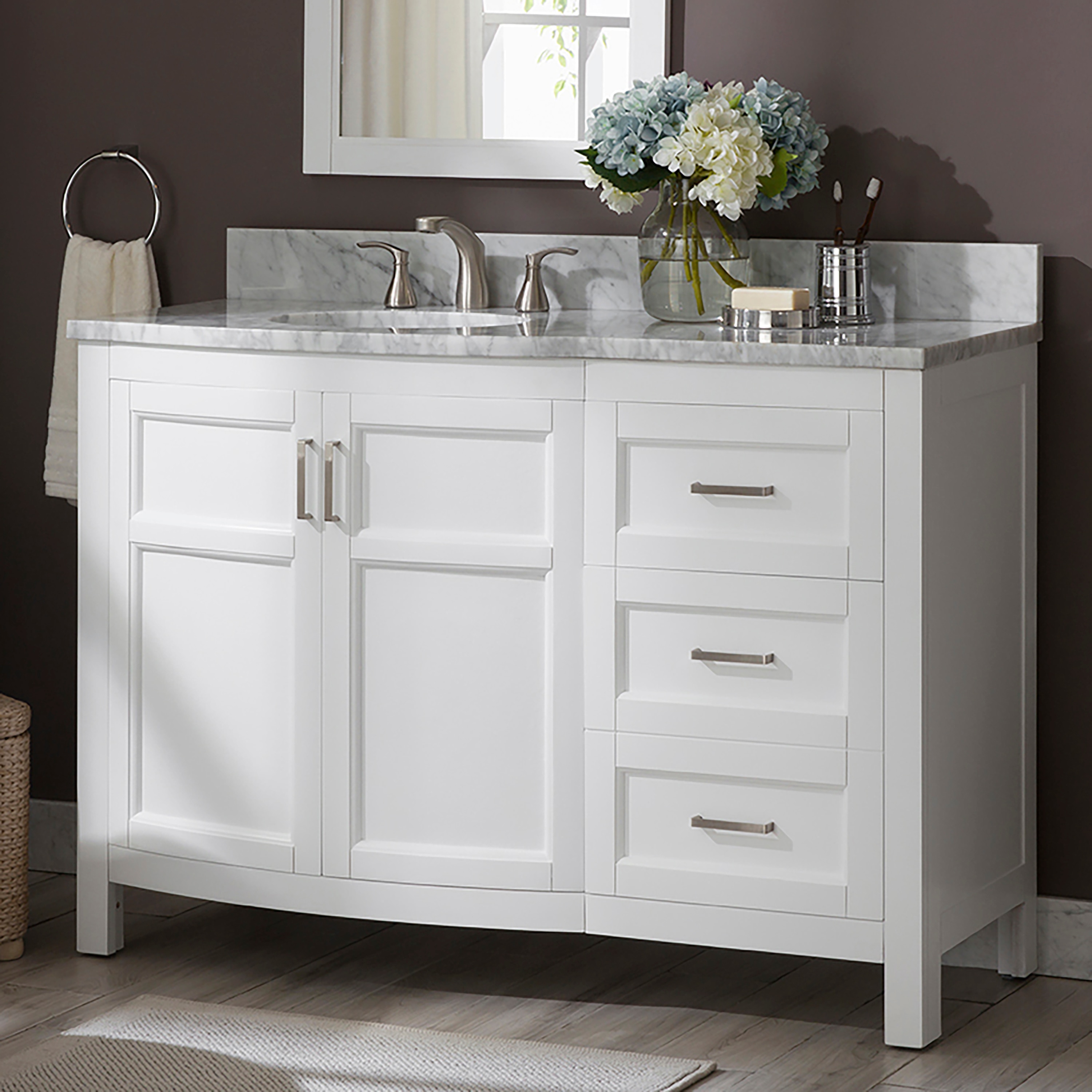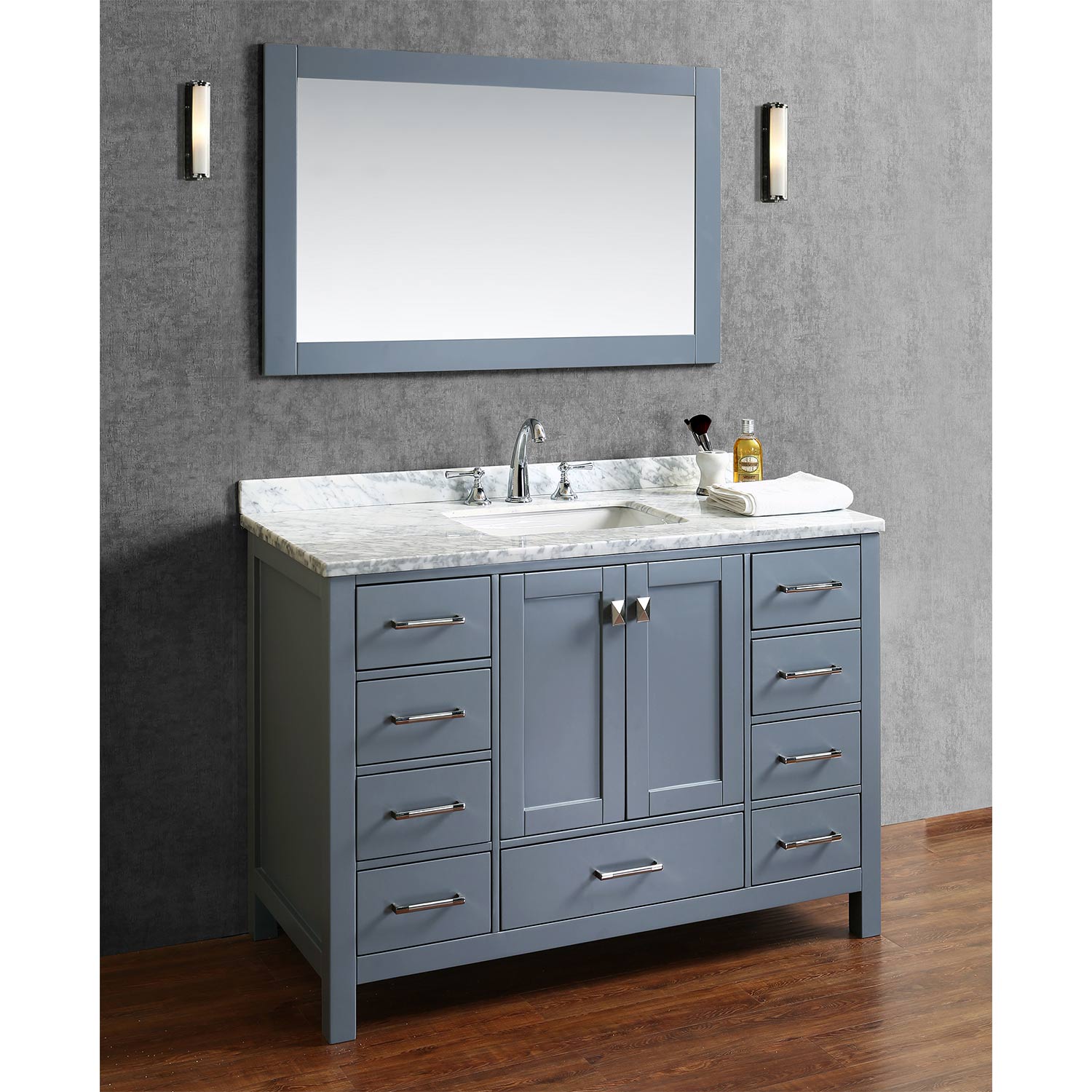Design and Functionality
A 48-inch bathroom vanity is a versatile piece of furniture that can elevate the style and functionality of any bathroom, regardless of its size. This size offers ample storage space and countertop area, making it a practical choice for both large and smaller bathrooms.
Benefits of a 48-inch Bathroom Vanity
A 48-inch bathroom vanity provides ample counter space for everyday tasks, such as applying makeup, brushing teeth, and styling hair. It also offers ample storage space for toiletries, towels, and other bathroom essentials. This size is particularly beneficial for:
- Larger Bathrooms: A 48-inch vanity can create a luxurious and spacious feel in a large bathroom, providing a dedicated area for grooming and personal care. It allows for multiple users to comfortably use the vanity simultaneously, ensuring a smooth morning routine.
- Smaller Bathrooms: While a 48-inch vanity may seem large for a small bathroom, it can actually optimize space by offering efficient storage solutions. By choosing a vanity with drawers, cabinets, and shelves, you can maximize storage and minimize clutter, making the bathroom feel more spacious.
Features and Functionalities
A 48-inch bathroom vanity typically features a combination of practical elements designed to enhance both functionality and aesthetics. These include:
- Storage Options: Vanities often come with drawers, cabinets, and open shelves to accommodate various bathroom necessities. Drawers provide concealed storage for toiletries, while cabinets offer ample space for towels, linens, and other items. Open shelves are ideal for displaying decorative items or storing frequently used items within easy reach.
- Countertop Materials: Countertops can be made from various materials, each offering unique characteristics. Some popular options include:
- Granite: Known for its durability, scratch resistance, and heat resistance, granite adds a touch of elegance to any bathroom.
- Quartz: A non-porous material, quartz is stain-resistant and easy to clean, making it a practical choice for busy bathrooms.
- Marble: With its timeless beauty and natural veining, marble adds a touch of luxury and sophistication to any bathroom. However, it is more susceptible to scratches and stains than other materials.
- Laminate: A cost-effective option, laminate offers a wide range of colors and patterns, making it a versatile choice for any bathroom style.
- Sink Styles: A 48-inch vanity can accommodate a variety of sink styles, each with its own advantages:
- Undermount Sinks: These sinks are installed beneath the countertop, creating a seamless and modern look.
- Top-Mount Sinks: These sinks sit on top of the countertop, offering a classic and traditional aesthetic.
- Vessel Sinks: These stylish sinks are often placed on top of the countertop, creating a focal point in the bathroom.
Design Styles
48-inch bathroom vanities are available in various design styles to complement any bathroom aesthetic. Some popular options include:
- Modern: Modern vanities often feature clean lines, minimalist designs, and sleek finishes. They are typically made from materials like stainless steel, glass, or high-gloss laminate.
- Traditional: Traditional vanities embrace classic design elements, such as ornate details, carved wood, and traditional finishes. They often feature a more ornate and elaborate aesthetic.
- Farmhouse: Farmhouse vanities evoke a rustic charm, often featuring distressed wood, weathered finishes, and simple designs. They create a cozy and welcoming atmosphere in the bathroom.
- Contemporary: Contemporary vanities combine modern elements with a touch of sophistication. They often feature clean lines, geometric shapes, and neutral colors.
Material and Construction

Choosing the right materials and construction techniques for your 48-inch bathroom vanity is crucial for its durability, water resistance, and overall longevity. Understanding the pros and cons of different materials and construction methods can help you make an informed decision that meets your specific needs and preferences.
Materials
The choice of materials for a bathroom vanity is critical, as it directly affects its durability, water resistance, and aesthetic appeal. Here’s a breakdown of common materials and their respective advantages and disadvantages:
- Wood:
- Advantages:
- Natural beauty and warmth
- High durability and longevity with proper care
- Versatility in styles and finishes
- Disadvantages:
- Susceptible to moisture damage if not properly sealed
- Can be expensive, especially for premium wood species
- Requires regular maintenance, including sanding and refinishing
- Advantages:
- Laminate:
- Advantages:
- Water-resistant and durable
- Wide range of colors and patterns to mimic wood or other materials
- Cost-effective compared to wood
- Disadvantages:
- Can be less durable than wood, especially in high-traffic areas
- Less resistant to scratches and heat
- May not be as aesthetically pleasing as natural wood
- Advantages:
- Acrylic:
- Advantages:
- Highly water-resistant and easy to clean
- Resistant to scratches and stains
- Available in a variety of colors and finishes
- Disadvantages:
- Can be less durable than wood or laminate
- May not be as aesthetically pleasing as wood or stone
- Can be more expensive than laminate
- Advantages:
Construction Techniques
The construction techniques used for a bathroom vanity significantly impact its durability, stability, and overall quality. Here are some common construction methods:
- Solid Wood Construction: This method uses solid wood boards for the entire structure, providing exceptional durability and longevity.
- Advantages:
- Exceptional durability and strength
- Can be refinished multiple times
- High resale value
- Disadvantages:
- More expensive than other construction methods
- Susceptible to warping and cracking if not properly sealed
- Advantages:
- Plywood Construction: This method uses plywood sheets for the vanity’s base and frame, providing a balance of durability and affordability.
- Advantages:
- More affordable than solid wood construction
- Less susceptible to warping and cracking than solid wood
- Provides a stable and durable base for the vanity
- Disadvantages:
- May not be as durable as solid wood construction
- Cannot be refinished as many times as solid wood
- Advantages:
- Particleboard Construction: This method uses particleboard, a less expensive material made from wood chips and sawdust, for the vanity’s base and frame.
- Advantages:
- Most affordable construction method
- Easy to work with and assemble
- Disadvantages:
- Least durable construction method
- Susceptible to moisture damage and warping
- Limited lifespan compared to other construction methods
- Advantages:
Installation and Maintenance: 48 Inch Black Bathroom Vanity

Installing a 48-inch bathroom vanity is a straightforward process that can be accomplished with basic DIY skills. Proper installation ensures that the vanity is secure, level, and functional. Maintenance practices are essential to preserving the vanity’s appearance and extending its lifespan.
Installing a 48-Inch Bathroom Vanity, 48 inch black bathroom vanity
The installation process typically involves the following steps:
- Prepare the Area: Clear the space around the intended location of the vanity. Remove any existing fixtures or cabinets. Ensure the wall is clean and free of debris.
- Locate Plumbing and Electrical: Determine the location of the water supply lines, drain pipe, and electrical outlet. Mark these locations on the wall for reference.
- Install the Vanity Base: Position the vanity base against the wall, ensuring it is level. Use a level to adjust the base as needed. Secure the base to the wall using appropriate mounting hardware, such as screws or anchors.
- Connect Plumbing: Connect the water supply lines to the vanity’s faucet. Ensure the connections are tight and secure. Attach the drain pipe to the vanity’s drain opening. Test the plumbing connections for leaks.
- Connect Electrical: Connect the electrical wiring to the vanity’s light fixture or any other electrical components. Ensure the connections are secure and meet electrical codes. Test the electrical connections to ensure they are functioning correctly.
- Install the Countertop and Sink: Install the countertop on the vanity base, securing it with appropriate hardware. Install the sink on the countertop, ensuring it is level and properly aligned.
- Final Touches: Install the vanity’s hardware, such as handles and knobs. Clean the vanity thoroughly to remove any debris or dust from the installation process.
Maintaining a 48-Inch Bathroom Vanity
Proper maintenance is crucial for preserving the beauty and functionality of a bathroom vanity. Here are some essential tips:
- Regular Cleaning: Clean the vanity regularly with a mild cleaner and a soft cloth. Avoid abrasive cleaners that can damage the finish.
- Prevent Water Damage: Wipe up spills immediately to prevent water damage to the vanity’s surface and underlying materials. Ensure the plumbing connections are tight and secure to prevent leaks.
- Ventilation and Moisture Control: Adequate ventilation is essential for reducing moisture buildup in the bathroom. Ensure the bathroom has a working exhaust fan and use it during and after showering or bathing. Consider using a dehumidifier to further control moisture levels.
- Address Common Issues: Address any minor issues promptly to prevent them from becoming major problems. For example, tighten loose screws, repair minor scratches, or replace damaged hardware.
Importance of Ventilation and Moisture Control
“Moisture buildup in a bathroom can lead to mold growth, warping of wood surfaces, and damage to the vanity’s finish.”
Proper ventilation and moisture control are essential for preserving the longevity of a bathroom vanity. An exhaust fan removes excess moisture from the air, preventing condensation and mold growth. A dehumidifier can further reduce humidity levels, creating a drier environment that is less conducive to moisture damage.
